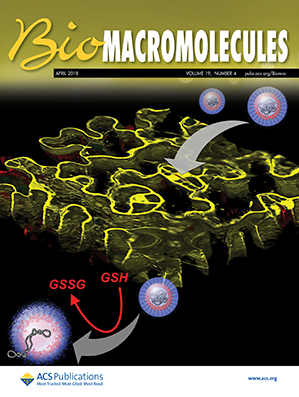为肝细胞特异性基因递送设计超声响应性聚糖聚合体
IF 5.4
2区 化学
Q1 BIOCHEMISTRY & MOLECULAR BIOLOGY
引用次数: 0
摘要
在设计肝脏靶向基因递送载体方面存在诸多困难,包括载体介导的细胞毒性和封装敏感核酸的挑战。在此,我们提出了一种超声响应糖聚体策略,用于原位装载核酸并实现肝细胞特异性基因递送。这种聚糖体由嵌段共聚物--N-乙酰半乳糖胺接枝聚(谷氨酸)-嵌段-聚(ε-己内酰胺)(PGAGalNAc-b-PCL)自组装而成。引入 GalNAc 可通过选择性地与肝细胞上过度表达的 Asialoglycoprotein 受体结合,实现肝脏靶向。利用外部超声波的超声响应特性,将核酸包裹在糖聚合体的亲水性内腔中。生物学研究证实,该方法能成功封装质粒 DNA (pDNA) 和小干扰 RNA (siRNA)、快速核内化和高效基因转染。这些研究结果共同表明,这种超声响应性糖聚合体可作为一种新型安全高效的基因载体用于靶向肝细胞。本文章由计算机程序翻译,如有差异,请以英文原文为准。
Engineering an Ultrasound-Responsive Glycopolymersome for Hepatocyte-Specific Gene Delivery
The ability to design liver-targeted gene delivery vectors is plagued with difficulties ranging from carrier-mediated cellular toxicity to challenges in encapsulating sensitive nucleic acids. Herein, we present an ultrasound-responsive glycopolymersome strategy for in situ loading of nucleic acids and achieving hepatocyte-specific gene delivery. This glycopolymersome is self-assembled from a block copolymer, N-acetylgalactosamine-grafted poly(glutamic acid)-block-poly(ε-caprolactone) (PGAGalNAc-b-PCL). GalNAc is introduced to afford liver targeting through the selective binding to the asialoglycoprotein receptor overexpressed on hepatocytes. External ultrasound is utilized to assist in encapsulating nucleic acids within the hydrophilic lumen of glycopolymersomes by exploiting their ultrasound responsiveness nature. Biological studies confirmed the successful encapsulation of plasmid DNA (pDNA) and small interfering RNA (siRNA), rapid nuclear internalization, and efficient gene transfection. These findings collectively demonstrated that this ultrasound-responsive glycopolymersome could be exploited as a novel safe and efficient gene vector targeting hepatocytes.
- Download: Download high-res image (215KB)
- Download: Download full-size image
求助全文
通过发布文献求助,成功后即可免费获取论文全文。
去求助
来源期刊

Biomacromolecules
化学-高分子科学
CiteScore
10.60
自引率
4.80%
发文量
417
审稿时长
1.6 months
期刊介绍:
Biomacromolecules is a leading forum for the dissemination of cutting-edge research at the interface of polymer science and biology. Submissions to Biomacromolecules should contain strong elements of innovation in terms of macromolecular design, synthesis and characterization, or in the application of polymer materials to biology and medicine.
Topics covered by Biomacromolecules include, but are not exclusively limited to: sustainable polymers, polymers based on natural and renewable resources, degradable polymers, polymer conjugates, polymeric drugs, polymers in biocatalysis, biomacromolecular assembly, biomimetic polymers, polymer-biomineral hybrids, biomimetic-polymer processing, polymer recycling, bioactive polymer surfaces, original polymer design for biomedical applications such as immunotherapy, drug delivery, gene delivery, antimicrobial applications, diagnostic imaging and biosensing, polymers in tissue engineering and regenerative medicine, polymeric scaffolds and hydrogels for cell culture and delivery.
 求助内容:
求助内容: 应助结果提醒方式:
应助结果提醒方式:


